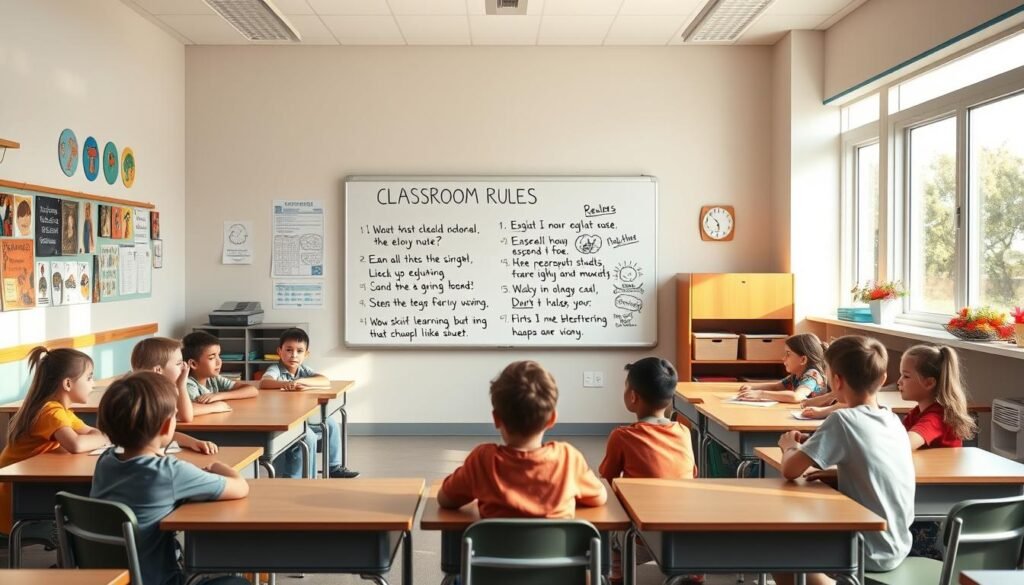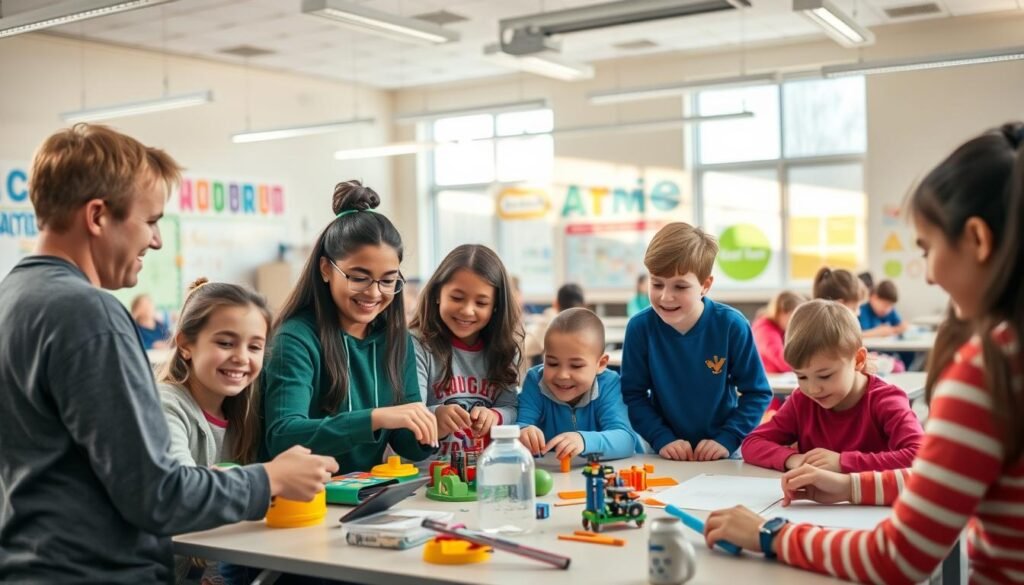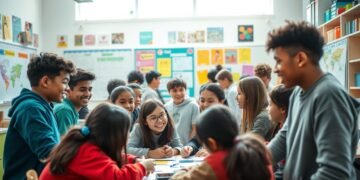Did you know that 50% of teachers feel unprepared to handle classroom management? This startling statistic highlights a critical challenge in education today. Creating a safe and engaging learning environment is essential for fostering positive behavior and academic success.
Research shows that implementing proven management strategies can transform the way students interact and learn. From modeling desired behaviors to using adaptive tools like Prodigy Math, educators have a range of options to enhance engagement and reduce disruptions.
This article explores seven core approaches backed by educational research. These methods not only improve classroom management but also create a foundation for long-term student success. Let’s dive into how you can build a more productive and harmonious learning space.
Key Takeaways
- 50% of teachers report feeling unprepared for classroom management.
- Research-backed strategies can improve student engagement and behavior.
- Tools like Prodigy Math support positive behavior and learning outcomes.
- Modeling desired behaviors is a foundational strategy for success.
- A safe learning environment is crucial for academic growth.
1. Model Ideal Behavior to Set the Tone
Setting the right tone starts with modeling the behavior you want to see. Teachers play a critical role in shaping how students interact with each other and the learning environment. By demonstrating polite language and respectful interactions, educators can establish clear expectations for their classrooms.
One effective method is using mock conversations to teach expected behavior. For example, role-playing scenarios can help students understand proper etiquette, such as maintaining eye contact or handling conflicts calmly. This hands-on approach makes lessons more relatable and memorable.
Demonstrate Polite Language and Respectful Interactions
Live demonstrations of teacher-student interactions can be a powerful teaching tool. Showcasing polite greetings, active listening, and thoughtful responses sets a standard for students to follow. These small actions can have a big impact on the classroom atmosphere.
Use Mock Conversations to Teach Expected Behavior
Scenario-based role plays are another great way to reinforce positive behavior. For instance, practicing the “STAR” method—Stop, Think, Act, Reflect—can help students manage their emotions during conflicts. Weekly challenges, like the “Golden Rule Challenge,” can also encourage students to practice specific social skills consistently.
2. Involve Students in Creating Classroom Rules
Empowering students to shape their own rules can lead to a more harmonious learning environment. When students have a say in setting classroom rules, they feel a sense of ownership and responsibility. This approach not only reduces disruptions but also fosters mutual respect.
Encourage Student Input on Acceptable Behavior
Start by facilitating a discussion where students share their ideas on acceptable behavior. Activities like “Constitution Building” allow them to vote on rules democratically. This process encourages group work and ensures everyone’s voice is heard.
Rotating student moderator positions can further reinforce accountability. By taking turns enforcing rules, students learn to uphold the expectations they helped create. This method also builds leadership skills and teamwork.
Document and Display the Agreed-Upon Rules
Once the rules are established, document them clearly. Visual aids like charts or Bitmoji integrations make the rules more engaging and accessible. Displaying these reminders prominently helps students stay aligned with the agreed-upon expectations.
Quarterly reviews with a suggestion box system ensure the rules remain relevant. This ongoing dialogue keeps the learning environment dynamic and responsive to student needs.
Research from Moreland University shows a 32% reduction in disruptions when students are involved in rule creation. This data highlights the effectiveness of a collaborative approach.
3. Address Disruptions Individually, Not Collectively
Focusing on individual behavior rather than collective punishment fosters accountability. When disruptions occur, addressing them privately can lead to faster resolutions. Research shows that private corrections resolve issues 40% faster than public callouts.
Use Friendly Redirection to Correct Behavior
Friendly redirection helps correct behavior without causing embarrassment. For example, using non-verbal cues like color cards or hand signals can discreetly guide students back on track. This approach maintains a positive atmosphere while addressing the issue.
Another effective method is the “2×10 Strategy.” Spend two minutes daily for ten days building rapport with challenging students. This simple yet powerful technique strengthens relationships and reduces disruptions.
Avoid Punishing the Entire Class for Individual Actions
Punishing the whole class for one student’s actions can create resentment. Instead, focus on individual consequences. Tools like ClassDojo allow teachers to track behavior discreetly, ensuring accountability without singling out students publicly.
Creating “Behavior Solution Kits” with reflection sheets and choice boards can also help. These kits empower students to take responsibility for their actions and learn from their mistakes.
A case study from PBIS Maryland highlights the success of this approach, showing a 58% improvement in behavior when individual accountability is prioritized.
4. Use Positive Reinforcement to Encourage Good Behavior
Positive reinforcement is a powerful tool for shaping student behavior. By acknowledging and rewarding positive actions, educators can create a supportive environment that motivates students to excel. Research shows that this approach not only improves behavior but also boosts confidence and engagement.
Praise Specific Achievements and Efforts
When students receive specific praise, they feel valued and understood. Instead of generic compliments, highlight exact actions, like “Great job explaining your reasoning in math class!” This type of feedback helps students recognize their strengths and encourages them to repeat positive behaviors.
Creating personalized praise playlists using Flipgrid video messages is another innovative way to celebrate achievements. These small gestures can have a lasting impact on student motivation.
Implement Reward Systems Like Raffle Tickets or Praise Notes
Implementing reward systems like raffle tickets or praise notes can further encourage good behavior. For example, a six-week trial using raffle tickets increased on-task behavior by 67%. This simple yet effective method keeps students engaged and motivated.
Partnering with local businesses for reward coupon partnerships or showcasing Baltimore City Schools’ PBIS reward store model can add excitement. These initiatives make recognition tangible and meaningful.
Involving parents in recognition programs, such as cross-grade “Kindness Ambassador” awards, strengthens the connection between home and school. This collaborative approach ensures that positive reinforcement extends beyond the classroom.
5. Incorporate Non-Verbal Communication Techniques
Non-verbal communication can transform how students engage with lessons and each other. By using visual cues and hands-on activities, educators can create a dynamic and inclusive environment. Research shows that these techniques improve retention and participation.
Use Visual Aids and Actions to Support Lessons
Visual aids like charts, diagrams, and gestures make lessons more accessible. For example, ASL-based silent signals for common requests can reduce disruptions. These tools help students focus without verbal reminders.
Creating tactile “focus tools” bins with fidget items and weighted lap pads can also support concentration. These resources cater to diverse learning needs and keep students engaged.
Implement Learning Stations for Diverse Engagement
Learning stations offer a structured way to incorporate variety into lessons. By rotating through different activities, students stay motivated and retain information better. Studies show a 45% improvement in retention compared to lecture-only formats.
Develop station rotation templates using Google Slides timers to keep transitions smooth. Incorporate movement breaks with GoNoodle between academic stations to maintain energy levels.
Examples from Whole Brain Teaching’s “Class-Yes” technique can also enhance engagement. These methods make learning interactive and fun while reducing distractions.
6. Build Excitement for Lessons to Minimize Disruptions
Engaging students from the start can make all the difference in maintaining focus and enthusiasm. When lessons are exciting, disruptions naturally decrease. Research shows that a “lesson teaser” approach reduces off-task behavior by 38%.
Preview Exciting Parts of the Lesson to Hook Interest
Start by giving students a sneak peek of what’s to come. Create Marvel-style movie trailers for upcoming units using tools like Animoto. These teasers build anticipation and curiosity.
Another creative method is the “Mystery Box” warm-up. Fill a box with tactile items related to the lesson and let students explore. This hands-on approach sparks interest and sets the stage for learning.
Use Engaging Activities to Maintain Focus
Incorporate interactive activities to keep students engaged. Develop escape room challenges using platforms like Genially. These games make learning fun while reinforcing key concepts.
Virtual field trips with Nearpod VR can also captivate attention. By immersing students in new environments, you create memorable learning experiences. These methods not only boost engagement but also reduce distractions.
Drawing inspiration from Dave Burgess’ “Teach Like a Pirate” hooks can further enhance your teaching. Whether it’s a dramatic entrance or a surprising prop, these techniques make lessons unforgettable.
7. Foster Strong Relationships with Students
Building trust with students is the cornerstone of a thriving learning environment. When educators prioritize relationships, students feel valued and supported. This approach not only improves behavior but also enhances academic performance.
Learn About Students’ Interests and Needs
Understanding students on a personal level can transform classroom dynamics. Start with activities like “Two Truths and a Dream,” where students share personal facts and aspirations. This icebreaker helps teachers connect with their students and address their unique needs.
Digital tools like Google Forms can be used to create interest inventories. These surveys provide insights into hobbies, learning preferences, and challenges. By tailoring lessons to these interests, educators can boost engagement and motivation.
Use Positive Phone Calls and Letters to Engage Parents
Engaging parents is equally important for fostering strong relationships. Positive phone calls or letters home can build trust and encourage collaboration. For example, a quick call to praise a student’s progress can strengthen the home-school connection.
Programs like Denver’s “Home Visit Project” show the impact of parent-teacher partnerships. Schools that combined student surveys with parent outreach saw a 72% improvement in behavior and engagement. Tools like the TalkingPoints app also help bridge communication gaps, especially in multilingual families.
By focusing on both students and parents, educators can create a supportive network that enhances learning and growth.
Conclusion: The Impact of Effective Classroom Discipline Strategies
Research from CASEL and PBIS.org highlights the transformative power of these approaches. They not only improve academic engagement but also foster positive relationships and a supportive learning environment. Teachers who implement these methods report reduced burnout and enhanced professional development.
These strategies are closely tied to social-emotional learning (SEL) outcomes. By focusing on individual needs and collaboration, educators can create spaces where students thrive. For a step-by-step guide, download the strategy checklist from Responsive Classroom.
Join our free webinar series with TeachLikeAChampion.org to deepen your understanding. Together, we can build stronger, more engaging classrooms. Take the next step by joining ASCD’s management community today.
FAQ
How can teachers model ideal behavior to set the tone?
Teachers can demonstrate polite language and respectful interactions. They can also use mock conversations to teach expected behavior, helping students understand what is acceptable.
Why is involving students in creating rules important?
Encouraging student input on acceptable behavior ensures they feel ownership of the rules. Documenting and displaying these agreed-upon rules keeps everyone accountable.
How should disruptions be addressed in the learning environment?
Disruptions should be handled individually, not collectively. Friendly redirection helps correct behavior without punishing the entire class for one student’s actions.
What role does positive reinforcement play in management?
Positive reinforcement encourages good behavior by praising specific achievements and efforts. Reward systems like raffle tickets or praise notes can further motivate students.
How can non-verbal communication enhance lessons?
Visual aids and actions support lessons effectively. Learning stations also engage diverse learners, making the experience more interactive and inclusive.
What techniques build excitement for lessons?
Previewing exciting parts of the lesson hooks interest. Engaging activities, such as group work or hands-on projects, help maintain focus and minimize disruptions.
How can teachers foster strong relationships with students?
Learning about students’ interests and needs builds trust. Positive phone calls and letters to parents also strengthen communication and support growth.






